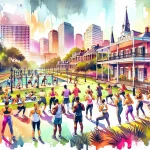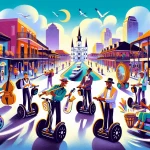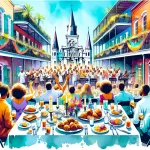The St. Charles Avenue Streetcar offers a captivating journey through New Orleans’ historical fabric, presenting an unparalleled opportunity to immerse oneself in the city’s distinctive architecture, neighborhoods, and allure. Recognized as the oldest continuously operating streetcar line worldwide, it has ferried locals and visitors alike along its picturesque route for over 180 years.
In This Article
TL;DR
- Originating in 1835, the St. Charles Avenue Streetcar is the oldest continuously running streetcar line globally.
- The 13.2-mile route traverses from Canal Street in the Central Business District through historic Garden District and Uptown neighborhoods, concluding at the Riverbend area.
- Key stops provide access to iconic attractions like the French Quarter, Audubon Park, Tulane University, and the antebellum mansions in the Garden District.
Historical Significance of the St. Charles Avenue Streetcar
An integral part of New Orleans‘ transportation system since its inception in 1835, the St. Charles Avenue Streetcar has evolved from horse-drawn rail cars to its current iconic green streetcars. Designated a National Historic Landmark in 1973, the line’s survival through challenges, including natural disasters and economic downturns, highlights its cultural importance and the city’s commitment to preserving this unique heritage.
The vintage streetcars, built by the Perley A. Thomas Company in the early 20th century, are engineering and design marvels. Their distinctive green color, wooden interiors, and open-air seating have become iconic symbols of New Orleans, capturing the city’s timeless charm and allure.
Detailed Route Analysis
The 13.2-mile St. Charles Avenue Streetcar route takes riders through some of New Orleans’ most iconic neighborhoods and attractions. Starting at Canal Street in the Central Business District, the streetcar heads uptown along St. Charles Avenue, passing through the French Quarter and the bustling commercial district.
One of the first major stops is Lee Circle, a historic landmark featuring a towering monument to Confederate General Robert E. Lee.
From there, the streetcar continues along St. Charles Avenue, offering stunning views of the oak-lined street and the grand antebellum mansions that line the route.
As the streetcar approaches Audubon Park, riders can disembark and explore this lush urban oasis, complete with walking trails, picnic areas, and the renowned Audubon Zoo.
Continuing uptown, the streetcar passes through the campuses of Tulane and Loyola Universities, providing easy access for students and visitors alike.
The Garden District, with its stunning Greek Revival and Italianate architecture, is a highlight of the route.
Visitors can hop off and stroll through the neighborhood, admiring the meticulously preserved homes and lush gardens that have earned the area its name.
Beyond the Garden District, the streetcar continues through the Uptown and Riverbend neighborhoods, offering glimpses of local life and charming residential areas. The final stop is at the intersection of St. Charles Avenue and Carrollton Avenue, where riders can explore the vibrant Riverbend area or transfer to other public transportation options.
Operational Details
The St. Charles Avenue Streetcar operates daily, with service typically beginning around 5:00 AM and running until midnight or later on weekends. The frequency of service varies throughout the day, with streetcars arriving every 10-20 minutes during peak hours and every 20-30 minutes during off-peak times.
Fares for the St. Charles Avenue Streetcar are affordable, with a one-way ride costing $1.25 for adults and discounted rates for seniors, students, and children. For visitors planning to use the streetcar extensively, the Jazzy Pass is an excellent option, offering unlimited rides for one, three, or thirty-one days at $3, $9, and $55, respectively.
The streetcars are designed to be accessible, with low-floor boarding and designated areas for wheelchairs and mobility devices. However, it’s important to note that the vintage streetcars may not have the same level of accessibility as modern public transportation vehicles. Riders with mobility concerns are encouraged to check the New Orleans Regional Transit Authority (NORTA) website or contact them directly for the most up-to-date accessibility information.
Riding Experience
Stepping onto one of the vintage St. Charles Avenue Streetcars is like stepping back in time. The wooden interiors, brass fittings, and open-air seating create a nostalgic ambiance that transports riders to a bygone era. While the lack of air conditioning can be a challenge during New Orleans’ hot and humid summers, the gentle breeze and the charm of the streetcar more than make up for it.
To fully appreciate the experience, it’s recommended to sit on the streetcar’s outer seats, which offer unobstructed views of the passing scenery. As the streetcar rumbles along the tracks, passengers can take in the sights and sounds of the city, from the majestic oak trees lining St. Charles Avenue to the lively street performers and buskers in the French Quarter.
One of the unique aspects of riding the St. Charles Avenue Streetcar is the opportunity to interact with locals. Commuters, students, and residents often use the streetcar for their daily travels, providing visitors with a glimpse into the city’s vibrant culture and way of life.
Key Stops and Attractions
While the entire St. Charles Avenue Streetcar route is a scenic journey, several stops stand out as must-visit destinations for visitors:
1. French Quarter:
Disembark at the Canal Street stop and explore the iconic French Quarter, with its colorful architecture, lively street performers, and world-famous restaurants and bars.
2. Audubon Park:
Get off at the St. Charles Avenue and Walnut Street stop to visit Audubon Park, a lush urban oasis featuring walking trails, picnic areas, and the renowned Audubon Zoo.
3. Tulane University:
The Audubon Street stop provides access to the historic Tulane University campus, with its beautiful architecture and vibrant student life.
4. Garden District:
Hop off at the Washington Avenue stop and stroll through the Garden District, admiring the stunning antebellum mansions and meticulously manicured gardens.
5. Superior Seafood & Oyster Bar:
For a taste of New Orleans’ renowned seafood, disembark at the Napoleon Avenue stop and visit Superior Seafood & Oyster Bar, a local favorite known for its fresh oysters and Cajun-inspired dishes.
Address: 4338 St Charles Ave, New Orleans, LA 70115
Phone: (504) 293-3474
6. Contemporary Arts Center:
Art enthusiasts can explore the Contemporary Arts Center, a cutting-edge art museum located near the Julia Street stop in the Warehouse Arts District.
Address: 900 Camp St, New Orleans, LA 70130
Phone: (504) 528-3800
Practical Tips for Riders
To make the most of your St. Charles Avenue Streetcar experience, consider the following practical tips:
- Purchase Tickets in Advance: Avoid long lines by purchasing your Jazzy Pass or individual tickets in advance through the NORTA app or at designated sales locations.
- Plan Your Route: Use the NORTA trip planner or consult the streetcar schedule to plan your route and ensure you catch the streetcar at the right time and location.
- Observe Streetcar Etiquette: Be mindful of other passengers by keeping your belongings close, avoiding loud conversations, and offering your seat to those in need.
- Stay Alert: While the streetcar ride is generally safe, it’s always a good idea to keep an eye on your surroundings and belongings, especially in crowded areas or at night.
- Dress for the Weather: New Orleans’ climate can be unpredictable, so dress in layers and be prepared for sudden changes in temperature or rain showers.
Comparison with Other New Orleans Streetcar Lines
While the St. Charles Avenue Streetcar is undoubtedly the most iconic and historic line in New Orleans, the city is also served by several other streetcar routes, each offering its own unique experiences and attractions.
The Canal Street Line, with its distinctive red streetcars, runs from the French Quarter to the City Park/Museum area, providing access to the New Orleans Museum of Art and the lush greenery of City Park.
The Riverfront Line, as its name suggests, follows the Mississippi River, offering stunning views of the city’s skyline and access to popular attractions like the Audubon Aquarium of the Americas and the Outlet Collection at Riverwalk.
In contrast to these more modern lines, the St. Charles Avenue Streetcar stands out for its vintage charm, historic significance, and the unparalleled scenery it offers along its route. From the grand antebellum mansions of the Garden District to the oak-lined streets of Uptown, the St. Charles Avenue Streetcar provides an immersive experience that truly captures the essence of New Orleans.
While the other streetcar lines are efficient and convenient for getting around the city, the St. Charles Avenue Streetcar is a destination in itself, offering a unique opportunity to step back in time and experience the city’s rich history and culture in a truly authentic way.






